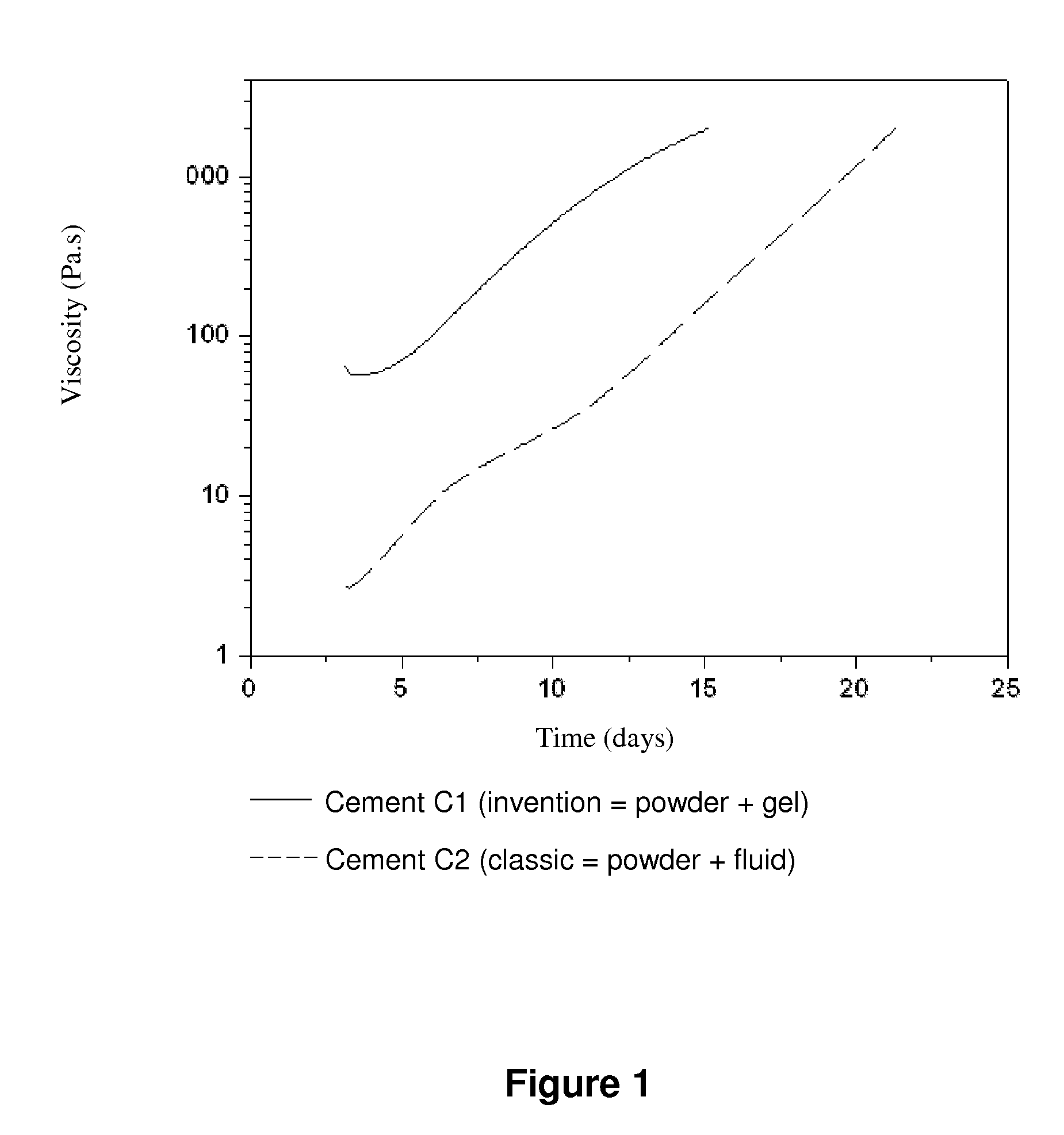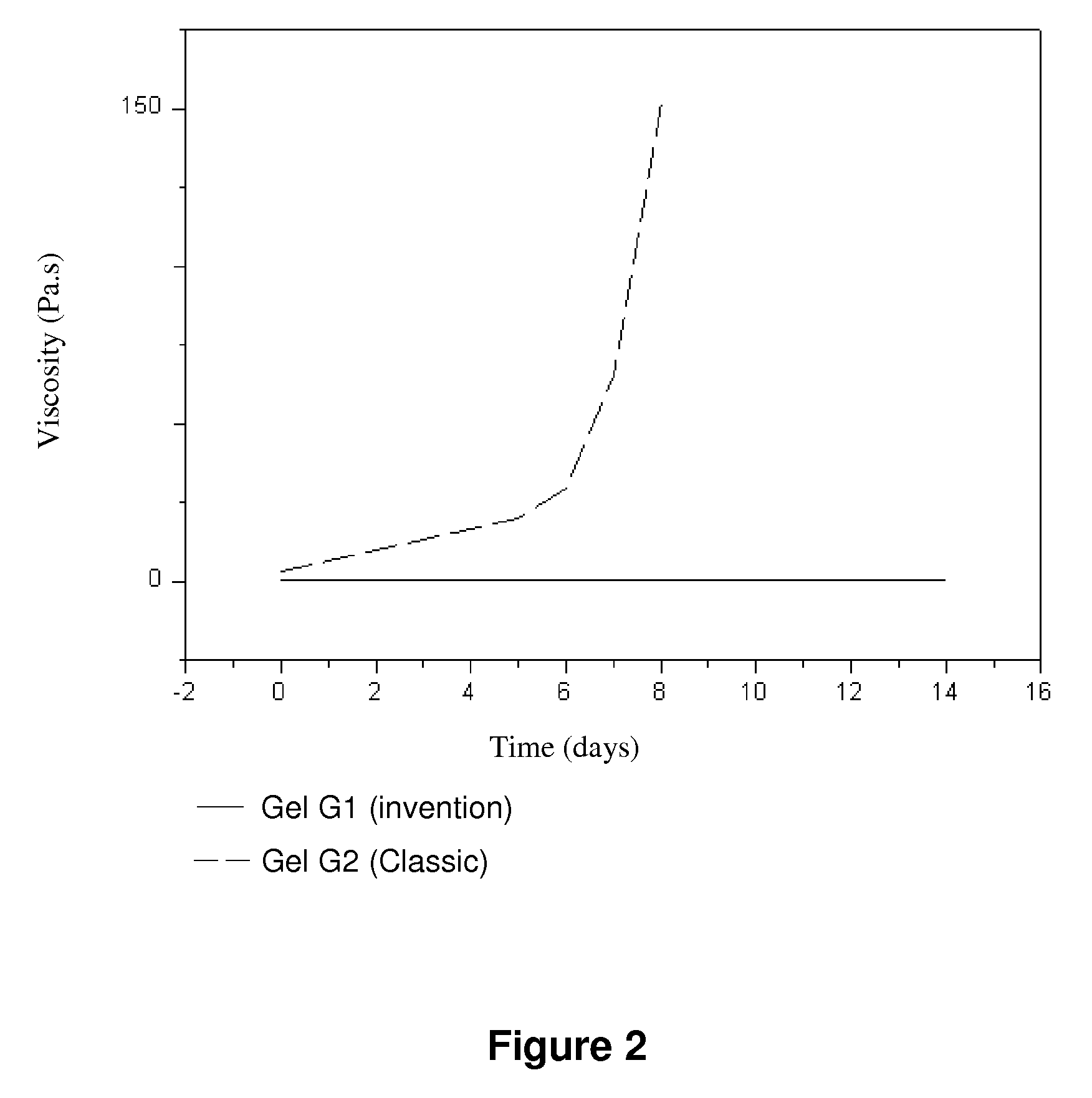Two-component system for bone cement
a technology of bone cement and acrylic cement, which is applied in the field of implantable biomaterials, can solve the problems that the origin of the specific problem of solidifying acrylic gel has not yet been identified, and achieve the effects of easy stabilization, long-term, and increased cement injection tim
- Summary
- Abstract
- Description
- Claims
- Application Information
AI Technical Summary
Benefits of technology
Problems solved by technology
Method used
Image
Examples
example 1
System for Preparing a Bone Cement According to the Invention
[0069]The first component of the system is formulated as follows (in weight contents):[0070]PMMA 49.5%[0071]Total BPo 0.5%[0072]Zirconium oxide 45%[0073]Hydroxyapatite 5%
[0074]A mixture of two grades of PMMA is used. Their molecular weight is respectively 400,000 g / mol and 200,000 g / mol, and their residual BPo 0.4% and 5%. The total BPo is provided by both the prepolymer and powder BPo added. A dry powder is obtained, which is a mixture of PMMA beads and other powder ingredients.
[0075]The second component is formulated as follows (in weight contents):[0076]MMA 94%[0077]PMMA 5%[0078]DMPT 1%[0079]HQ 20 ppm
[0080]The PMMA used has a molar mass of 1,500,000 g / mol and is free of residual BPo.
[0081]The residual BPo is measured by a standard technique of potentiometry. PMMA is dissolved to release its BPo. BPo solution reacts with iodide ions to form iodine, I2, which in turn is determined by sodium thiosulfate. The method provide...
example 2
Comparative Evolution of the Viscosity of a Conventional Cement and a Cement According to the Invention
[0087]The cement prepared according to Example 1 (C1) is compared to a C2 cement, prepared from a first component same as above, and a second component expressed as follows (in weight contents):[0088]MMA 99%[0089]DMPT 1%[0090]HQ 20 ppm
[0091]This gives a fluid viscosity of approximately 0.01 Pa.
[0092]A C2 cement is prepared by mixing the two components to the tune of 27.2 g of powder and 9.2 g of liquid.
[0093]It is noted that the total amounts of prepolymer and monomer made by the two components have been established so that the polymer / monomer ratio is maintained between the two cements. This ratio is 1.6 for C1 as for C2.
[0094]Both C1 and C2 cements are prepared using the protocol described in Example 1. The evolution of the viscosity is recorded as a function of time. The measurement is stopped when the viscosity is greater than 1,500 Pa·s. FIG. 1 shows the measurement results.
[0...
example 3
Stability of the Gel During its Preservation
[0097]The stability of two gels during their preservation and storage was studied. G1 gel is prepared according to the invention, while G2 gel is formulated with a classic recipe. The formulations can obtain two gels with very similar initial viscosity, the evolution of which can be compared. The values are the weight contents.
[0098]G1 Gel:[0099]MMA 94%[0100]PMMA 5%[0101]DMPT 1%[0102]HQ 20 ppm
[0103]The PMMA used has a molar mass of 1,500,000 g / mol and it is completely free of residual BPo. The gel obtained has a content of 0% BPo, and its viscosity rises to 0.2 Pa·s.
[0104]G2 gel:[0105]MMA[0106]PMMA 20%[0107]DMPT 1%[0108]HQ 20 ppm
[0109]The PMMA used has a molecular weight of 450,000 g / mol and a residual BPo content less than 0.8%. The gel obtained has a content of 0.2% BPo and its viscosity is 1 Pa s
[0110]The gels are prepared using the protocol outlined in Example 1. The evolution in time of the viscosity of two gels is determined. The tes...
PUM
| Property | Measurement | Unit |
|---|---|---|
| viscosity | aaaaa | aaaaa |
| viscosity | aaaaa | aaaaa |
| viscosity | aaaaa | aaaaa |
Abstract
Description
Claims
Application Information
 Login to View More
Login to View More - R&D
- Intellectual Property
- Life Sciences
- Materials
- Tech Scout
- Unparalleled Data Quality
- Higher Quality Content
- 60% Fewer Hallucinations
Browse by: Latest US Patents, China's latest patents, Technical Efficacy Thesaurus, Application Domain, Technology Topic, Popular Technical Reports.
© 2025 PatSnap. All rights reserved.Legal|Privacy policy|Modern Slavery Act Transparency Statement|Sitemap|About US| Contact US: help@patsnap.com


